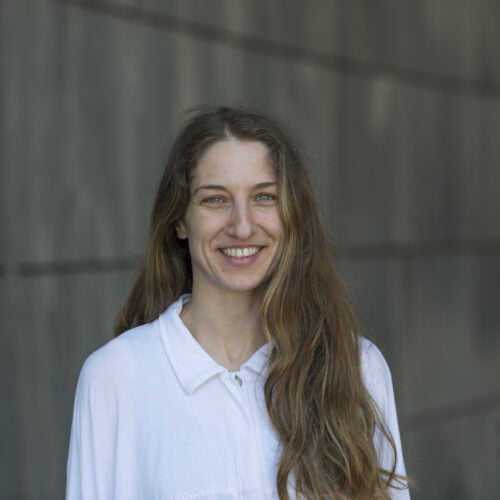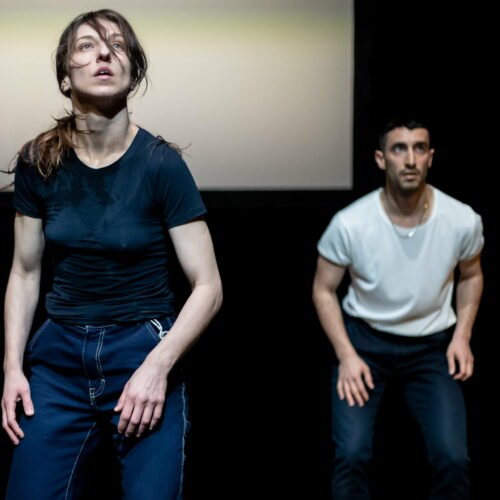Explosively intense, repetitive and distorted in a multimedia installation.
TicketsVenue
Duration
40 minutes
23 Apr
19:00
24 Apr
19:00
Puddles of water, sandboxes and metallic vessels, together with the (micro) movements of the body, create a soundscape that intensifies, explodes, pauses, repeats and distorts. The dancers interpret the archive material live and thus decide what will be brought to life in the theatre space through sound. MOS is a scenic game that operates among obvious and hidden relations and exists between movement, sound and image.
Ioanna Paraskevopoulou is a Greek choreographer and this is her first time in Sweden.
* The word/acronym 'mash' has more than twenty different definitions.
Here is a selection: make optical splices / microphone off stage / microphone out of service / minus optical signal /minus optical stripe / minus optical sound / missing of sound / mit ohne stimme / mit out sprechen / mixer out smoking / motion on screen / motor only shot / motor only sync /music on side / muted on screen / muted on sound / muted optical stripe.
Artists presented in the framework of Aerowaves, co-funded by the European Union.



About Ioanna Paraskevopoulou
Ioanna Paraskevopoulou is a dancer and choreographer based in Athens. She graduated from the Greek National School of Dance and currently studies at the Department of Audiovisual Arts (Ionian University). Her artistic practice focuses on the relationship between audiovisual media and movement. She has collaborated with, among others, Iris Karayan, Christos Papadopoulos, Dimitris Papaioannou, Alexandra Waierstall, Katerina S. Andreou and Lenio Kaklea. She has been awarded the Stavros Niarchos Foundation Artist Fellowship by ARTWORKS (2019).
She created her choreographic video project All She Likes Is Popping Bubble Wrap as part of the Onassis New Choreographers Festival 8. ALSIPBW won the best sound design award at the FIVideodanza festival and the best video art award at MIFVIF. She co-created the video dance Battle of Fishes in the context of Miniatures For Revolution. Battle of Fishes won the 'Best Cinematography Award' at the InShadow Lisbon Screendance Festival.
She presented Mos at the Onassis New Choreographers Festival 9. She also presented the 10-minute piece Coconut Effect at the 7th edition of the Danse élargie competition with which she won the Young Jury Award. Mos was selected by Aerowaves Twenty23 and continues to tour as part of international festivals.

Ioanna Paraskevopoulou on the MOS performance
Read an interview with choreographer Ioanna Paraskevopoulou about MOS - an explosively intense, repetitive and distorted performance at Dansens Hus Elverket, 23-24 April 2024.
Read the full interview, originally published on Dance Art Journal: Ioanna Paraskevopoulou in conversation with Giordana Patumi.
What is MOS and is there anything that inspired you to create this work?
- MOS is a scenic game, a work that arises from the combination of different materials and media. It is my attempt to create a dialogue between movement, sound and image. I discovered the Foley technique during the pandemic from a YouTube video where Foley artists recreated the sound of film scenes. I was immediately intrigued by the idea and created a video project entitled "All she likes is popping bubble wrap", where I experimented with this idea in a recording studio. I then developed these correlations in a 40-minute live project: the duet MOS.
Have you gained any insights into the creative process while developing this work?
- The process was fun and quite playful! We started by trying different games, focusing first on dances that appear in films. For a while, we experimented with sounds from different objects and which sound best matched the image, in turn creating the most accurate "texture" for each visual clip I had accumulated. Every day before rehearsals, I would go to a shop and buy different materials: wood, metal and other things that we could walk, run and step on to create different sound qualities. We took tap dancing lessons. I definitely wanted the music to emerge from our dancing. For quite some time during the process of making MOS, the dramaturgy of the performance was completely scattered in my head, except for some parts that I was sure of. Then one day I suddenly saw the whole piece in front of me as a vision! I told it to Georgios, my co-dancer, and it started to take shape.
Does MOS challenge or push the boundaries of traditional dance forms or techniques?
- I don't know if I can say that MOS pushes the boundaries of the traditional. It is definitely a work that is quite experimental in concept, as I use a certain kind of sound technology and turn it into a tool for choreographic composition. Nowadays, borders, identity and categorisation are blurring in art. All artists are experimenting with an indeterminate idea from our minds, whether in a studio or elsewhere. The word experiment is just a word - and sometimes words become a misrepresentation of the content.
What matters and is important to me is the immediacy and the feeling that a performance evokes. Many experiments have been done. Many ideas have been embodied. Much around us is chaotic. I believe that MOS succeeds by being accessible and direct, which was my goal. To create something that would have an immediate impact on the audience.
Are there any specific messages or ideas that you hope to convey through MOS?
- I have a strong relationship with everything that passes - the memories and imprints it leaves behind. I am interested in the reproduction of audiovisual elements and what they represent in the present. A kind of visibility of the processes that happen behind the scene. Yet there is nothing specific that MOS handles; the performance captures a function - in this case sound and image in relation - and through this creates a sensory experience that tickles the audience's senses.
Is there any moment in MOS that you think is particularly worth highlighting?
- It is always interesting to observe audience reactions. They vary from country to country. There are moments when the audience always laughs, and those are also the moments that give me the energy to continue with my work.
As a choreographer, what do you personally hope to achieve or communicate through your work, including MOS?
- As an audience member myself, I find a performance most moving when I am drawn into it, feel emotions, remember something and relate to it. Therefore, as a creator, I want to evoke emotions. I want to be able to convey what is happening to me on stage.
What challenges did you face when incorporating everyday objects such as umbrellas, drain cleaners and coconut shells into the choreography?
- The challenge lay in how the props would work as sound and could be amplified in the theatre space. This was difficult! Usually sound effects for films are created in a recording studio, where there are technical aids and necessary equipment, but here we are live in a theatre. Despite this, it brought the most joy and playfulness to our process and the fact that we use them seriously only adds to the entertainment value of the performance.
What do you hope audiences will take away from the experience of MOS? What can audiences expect to experience or feel when they see MOS, and how do you see MOS resonating with different audiences, including those who may not be familiar with contemporary dance?
- I really encourage audiences who are not familiar with contemporary dance to come and see the performance. MOS is a work that by its nature and combination of sound, image and movement can appeal to people with multiple experiences.
Read the full interview, originally published on Dance Art Journal: Ioanna Paraskevopoulou in conversation with Giordana Patumi.
Meet choreographer Ioanna Paraskevopoulou in conversation with Stacey Sacks, performer and researcher, Stockholm University of the Arts.
MOS succeeds in being a fascinating, intimate, and moving experiment in sound design and dance
"Truly captivating"
Concept and choreography
Ioanna Paraskevopoulou
Dancers
Georgios Kotsifakis, Ioanna Paraskevopoulou
Sound engineering and design
Danis Chatzivasilakis
dramaturge
Elena Novakovits
Lighting design
Eliza Alexandropoulou
Travelling light design
Eliza Alexandropoulou, Tzanos Mazis
Video technology
Efthimis Tikellis, Konstantinos Asimakopoulos
Stage design and costumes
Ioanna Paraskevopoulou
Video editing
Ioanna Paraskevopoulou
Wooden structures
Miltos Athanasiou
Graphical form
Bois Futuri
Producer
Ioanna Paraskevopoulou
Tour producer
Cultόpια & Ioanna Paraskevopoulou
With the support of
Onassis STEGI's "Outward Turn" Programme.
Produced by
Onassis STEGI and first presented as part of Onassis New Choreographers Festival 9
Special thanks to
Eleni Tzarou, Thanos Daskalopoulos, Alexandros Tomaras
Photographers
Pinelopi Gerasimou, Patricio Cassinoni












